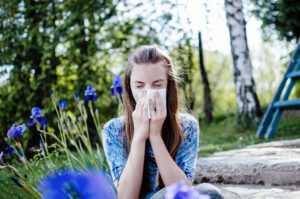Several age-old remedies exist to heal lungs and throat while relieving a nagging cough. Here are the six top remedies that heal lungs and throat, including two popular European medicinal herbs (coltsfoot and mullein) and four plants from Chinese medicine.
Balloon Flower – Platycodon grandiflorus (Campanulaceae)
A heavy bloomer with star-shaped flowers, Balloon Flower is native to the far East. The root is edible, increases cellular glutathione (GSH) and contains platycodigenin along with saponins. Balloon Flower is used in the treatment of coughs and colds along with sore throat and toothache. Balloon Flower is said to be one of the easiest perennials to grow in the home garden. In Japan, Balloon Flower is used in soup and is pickled or sweetened with sugar and used as a tonic. Balloon Flower has diuretic, expectorant and anti-inflammatory properties.
Chayote – Sechium edule (Cucurbitaceae)
A one-seeded member of the Gourd family, chayote is native to the tropical regions of South and Central America. Chayote contains 93% moisture along with 17 amino acids including threonine, leucine, arginine, phenylalanine, istidine, lysine. Chayote contains vitamin K, calcium, iron and zinc. Chayote is used to treat bronchitis, enhance the immune system, reduce arteriosclerosis, relieve hypertension and dissolve kidney stones. Chayote can be consumed raw or cooked, and is often served with lemon juice. Chayote has diuretic and anti-inflammatory properties.
Coltsfoot – Tussilago farfara (Compositae)
A perennial herb growing 12 inches high, coltsfoot has yellow-gold flowers and is indigenous to Europe, northern Asia, and North America. Coltsfoot contains about 8% flavonoids, 10% tannins, polysaccharides, Vitamin C, and Zinc. One of the oldest cough treatments among European remedies, coltsfoot leaves are steeped and consumed as a tea. Caution: The pyrrolizidine alkaloids of this plant may have a toxic effect on the liver but that effect is normally destroyed when the leaves are steeped as a tea. Do not take for more than 3-4 weeks at a time, nor while pregnant or breast feeding. Not suitable for children under 6. Coltsfoot has expectorant, demulcent, anti-inflammatory and antispasmodic properties.
Mullein – Verbascum Thapsus (Scrophulariaceae)
A flowering biennial from the figwort family, Mullein is native to Europe and Asia. Mullein contains large amounts of mucilage and is revered for its soothing properties. Traditionally used as an expectorant, mullein makes a cough more productive. The unusually fuzzy green leaves and flowers are used internally to treat bronchitis, migraines and colds, and also can be used externally as a wound healer. Used as a hair dye and as rouge for Roman women, the flowers are steeped in olive oil and the resulting blend is used to treat ear infections. Also used to treat hemorrhoids and diarrhea, mullein combines well with other expectorants and is normally made into a tea. Mullein has antibacterial, anti-inflammatory, astringent and demulcent properties.
Plum Flower – Polygonum multiflorum (Polygonaceae)
An herbaceous, climbing vine, Plum Flower is native to Japan and is used in both Chinese and Ayurvedic medicine as a rejuvenating tonic. Not to be confused with flowers from the Plum tree, the root of Plum Flower (aged a minimum of 4 years) is the part used. Plum Flower contains anthraquinones, phospholipids (including lecithin), and tetrahydroxystilbene glucoside. Plum Flower (also known as He Shou Wu or Fo-Ti) is a bitter and is considered by many to be among the best longevity herbs. According to Chinese medicine, the yin (body fluids) and yang (fire of life) must exist in harmony for the body to age gracefully, and plum Flower restores “qi”, or energy flow. Plum Flower is used to lower the discharge of mucous and secretions. Plum Flower nourishes the hair to treat premature graying. Plum Flower increases sex drive, calms the nerves, lowers cholesterol and tones the blood vessels. Plum Flower does not lend itself to tea, and instead is used as a tincture or in powdered form mixed with juice. Plum flower has laxative, anti-aging and adaptogenic properties.
Sterculia – Scaphium lychnophorum (Sterculiaceae)
A tree that grows up to 30 meters high, sterculia is native to mainland Southeast Asia. Sterculia (also called Poontalai, Pangdahai, and Samrong) contains alkaloids including sterculinine and sterculinine II along with Polysaccharide PP III. The flesh surrounding the dried sterculia seeds (which resemble almonds) expands to eight times its original volume to form a gelatinous mass that is removed and used in Chinese medicine. Sterculia is used to cure lung and throat problems, to reduce toxicity, to relieve constipation, and to soothe bloodshot eyes. Sterculia seed pulp is often mixed with sugar and basil seeds to make a cooling drink in Vietnam, Thailand and Cambodia. In China, sterculia is used in tea along with sugar candy to reduce “hotness”. Sterculia has expectorant and anti-inflammatory properties. Caution: Avoid consuming more than three sterculia seeds per drink (overconsumption symptoms include white watery phlegm and swollen tongue). People with frequent digestion problems should avoid sterculia entirely.



